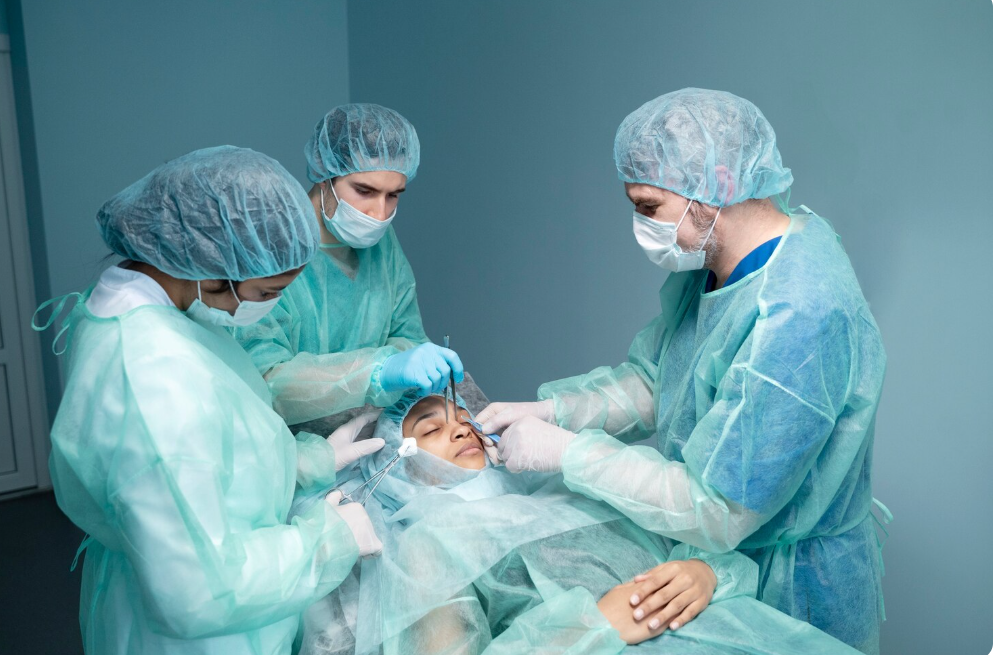Treatment Overview
Korean Bridge Augmentation Ethnic Rhinoplasty is a specialized procedure designed to enhance the height, projection, and definition of the nasal bridge. Many patients from Asian, African, Hispanic, and other ethnic backgrounds naturally have lower or flatter nasal bridges. This can sometimes create less facial balance or definition, especially in profile views.
In Korea, surgeons use silicone implants, Gore-Tex, or autologous cartilage (rib, septal, or ear) to augment the nasal bridge. The goal is to achieve a refined, natural, and proportionate bridge height while preserving the patient’s ethnic identity. Korean surgeons are globally recognized for creating smooth, natural-looking results that blend seamlessly with the rest of the face.
Purpose & Benefits
- Enhances nasal bridge height for improved facial harmony.
- Creates a more defined profile and stronger nasal structure.
- Maintains ethnic identity while refining proportions.
- Smooths irregularities or flat areas of the bridge.
- Can be combined with tip refinement for complete nasal enhancement.
- Long-lasting, natural results with advanced Korean techniques.
Ideal Candidates
- Individuals with a naturally low, flat, or undefined nasal bridge.
- Patients who want more definition without looking “overdone.”
- Those who have previously had unsuccessful augmentation and seek revision.
- People in good health with realistic expectations.
- Patients who wish to maintain ethnic balance while improving structure.
Possible Risks & Complications
Though safe with Korean specialists, risks include:
- Temporary swelling, bruising, or redness.
- Implant shifting (rare with advanced fixation techniques).
- Infection or scar tissue formation.
- Over-augmentation leading to unnatural results.
- Need for revision in rare cases.
Surgical Techniques Used
Korean surgeons use multiple bridge augmentation methods, tailored to patient anatomy:
- Silicone Implant Augmentation: Widely used for smooth, defined bridge height.
- Gore-Tex Implant Augmentation: Provides a softer, natural feel with tissue integration.
- Cartilage Grafting (Autologous): Using rib, ear, or septal cartilage for natural and permanent augmentation.
- Hybrid Augmentation: Combination of cartilage at the nasal tip with implants for bridge definition.
- Customized Shaping: Implants sculpted to match patient’s facial ratios.
Recovery & Aftercare
- Downtime: Most patients resume daily activities within 7–10 days.
- Swelling & Bruising: Gradually decreases in 2–3 weeks.
- Splint & Sutures: External splints worn for about 5–7 days; sutures removed within a week.
- Final Results: Visible after 2–3 months, with full refinement in 6–12 months.
- Aftercare Support: Korean clinics provide anti-swelling therapies, laser scar care, and regular follow-up.
Results & Longevity
- Provides a permanent increase in bridge height when autologous cartilage is used.
- Silicone and Gore-Tex implants can last 10–20 years with proper care.
- Results look natural, stable, and maintain ethnic harmony.
- Boosts facial balance, especially in profile view.
Treatment Process in Korea
1. Consultation
- 3D facial scanning and digital morphing to preview outcomes.
- Detailed planning based on ethnicity, facial ratios, and patient goals.
2. Pre-Surgery Preparation
- Medical examination, nasal imaging, and blood tests.
- Selection of implant or graft material (silicone, Gore-Tex, cartilage).
3. Surgery
- Performed under local anesthesia with sedation or general anesthesia.
- Procedure time: 1–2.5 hours, depending on complexity.
- Incisions are usually hidden inside the nostrils or at minimal external sites.
4. Immediate Post-Surgery Care
- External splint applied for support.
- Monitoring in recovery rooms for a few hours before discharge.
5. Follow-Up & Aftercare
- Stitches removed in 5–7 days.
- Swelling management with LED therapy, massage, and medication.
- Regular check-ups, often with English-speaking coordinators for foreigners.
Why Korea?
- Global Leaders in Ethnic Rhinoplasty: Korean surgeons are highly skilled in bridge augmentation while preserving ethnic identity.
- Advanced Surgical Materials: Customized implants and refined cartilage grafting methods.
- Natural Results Philosophy: Focus on harmony and subtlety, avoiding exaggerated outcomes.
- Medical Tourism Hub: Clinics provide interpreters, concierge services, and post-op care for international patients.
Cost Range
The price of Korean Bridge Augmentation Ethnic Rhinoplasty varies based on material (implant vs cartilage), surgeon’s expertise, and clinic reputation.
- Silicone Implant Bridge Augmentation: ₩4,500,000 – ₩7,000,000 KRW ($3,500 – $5,600 USD)
- Gore-Tex Implant Augmentation: ₩5,000,000 – ₩7,500,000 KRW ($3,900 – $6,000 USD)
- Cartilage Graft (Rib or Septal): ₩7,500,000 – ₩12,000,000 KRW ($6,000 – $9,600 USD)
- Hybrid Augmentation (Cartilage + Implant): ₩8,500,000 – ₩13,000,000 KRW ($6,800 – $10,400 USD)
Basic Packages Include: Surgeon’s fee, anesthesia, surgery, and standard follow-ups.
Premium Packages May Include:
- VIP recovery suites
- 3D morphing consultations
- English translator services
- Swelling reduction therapies (LED, lymphatic massage)
- Full medical tourism support (airport pickup, hotel, concierge)
Compared to Western countries, Korea provides world-class expertise at more affordable pricing, making it a top choice for patients worldwide.
Popular Clinics
- ID Hospital (Seoul): Specialized in bridge augmentation with implants and cartilage.
- Banobagi Plastic Surgery: Known for smooth, natural bridge enhancement.
- JW Plastic Surgery: Strong reputation for cartilage-based augmentation.
- View Plastic Surgery: Popular among international patients with medical tourism services.
- MINE Plastic Surgery: Expert in hybrid augmentation with natural, ethnic-preserving outcomes.




